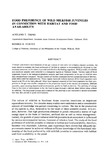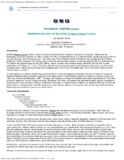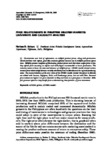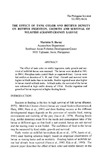Food preference of wild milkfish juveniles in connection with habitat and food availability
Share
Abstract
Through quantitative determination of the gut content of wild milk fish (Chanos chanos) juveniles, the study aimed to evaluate the food preference of the fish in relation to its availability in the pond so that necessary measures can be taken to provide such food to the feeding organisms. Wild juveniles of milkfish and plankton samples were collected in a mangrove lagoon at Nabunut Island. Various types of food organisms found in the mangrove plankton samples and food components in the gut of milkfish were then tabulated and compared. The gut content of the fish examined showed a preponderance of detritus, plant debris and fine sand particles. These organic materials without mixture of live food organisms were found in 64.5% of the fish collected. Other food ingested consisted of live food organisms but their proportion in the gut was smaller compared to the proportion found in the natural environment. Milkfish juveniles, upon entering depositional environments, prefer to feed on detritus. The pathway of energy flow in the kind of environment is for the food to pass through a detrital chain before being utilized by milkfish. The functional concept and evidence of this pathway is not restricted to natural ecosystems but may also prevail in pond environments.
Suggested Citation
Triño, A. T., & Fortes, R. D. (1989). Food preference of wild milkfish juveniles in connection with habitat and food availability. Journal of Aquaculture in the Tropics , 4, 1-7. http://hdl.handle.net/10862/1306
Subject
Taxonomic term
Collections
- AQD Journal Articles [1240]
Related items
Showing items related by title, author, creator and subject.
-
Fisheries biology of milkfish (Chanos chanos Forskal)
Garcia, Luis Maria (Food and Agriculture Organization of the United Nations, South Pacific Aquaculture Development Project, 1990)Milkfish (Chanos chanos Forskal) is one of the most important food fish species in the world. In Indonesia, Taiwan and the Philippines, more than a quarter of a million tonnes of milkfish are harvested annually in brackish ... -
Price relationships in Philippine milkfish markets: Univariate and causality analysis
Salayo, Nerissa D. (International Association of Aquaculture Economics and Management (IAAEM), 2006)Uncertainties and lack of information on milkfish product prices, along with production-related problems with inputs, generally constrain efficient resource use in milkfish grow-out operations. Milkfish growers complain ... -
The effect of tank color and rotifer density on rotifer ingestion, growth and survival of milkfish (Chanos chanos) larvae
Duray, Marietta N. (San Carlos Publications, University of San Carlos, 1995)The effect of tank color on rotifer ingestion, early growth and survival of milkfish larvae was assessed. The larvae were stocked at 30/L in 200-L fiberglass tanks coated black or unpainted (tan). Larvae were fed rotifers ...






